5 MIN READ
Sorghum Growth Stages
November 9, 2021
Growth Stages of Sorghum
• Sorghum crop management begins with understanding sorghum plant growth and development.
• Short season and full season sorghum crops require a different number of growing degree unit accumulation for panicle initiation.
• Although sorghum can tolerate poor environmental conditions, management can help increase yield potential.
Identifying Plant Structures
Identifying key sorghum plant structures helps with understanding sorghum growth and development. The coleoptile is the first leaf that emerges from the ground. The coleoptile looks different than other leaves because it has a rounded leaf tip. The leaf collar, where the leaf blade and leaf sheath meet, will become visible once a leaf has completed development. This intersection occurs at a node. The flag leaf is the final leaf to develop and is often smaller than the other leaves. Lastly, the panicle (head) emerges from the flag leaf sheath and is supported by the peduncle (stem holding the head) (Table 1).1
Days after Emergence to Determine Growth Stage
Table 1. Identifying characteristics and approximate time intervals between sorghum growth stages.
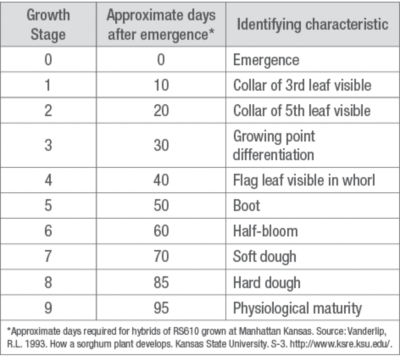
The exact timing between sorghum growth stages can vary depending on sorghum products, plant population, environmental conditions, growing conditions, and region. To determine the leaf stage of a sorghum plant, the number of leaves with visible leaf collars should be counted. If the lowest leaf does not have a rounded tip, then a minimum of one leaf has been lost.
Stage 0. Emergence may occur between three to ten days after planting depending on soil temperature, moisture, planting depth (one to two inches), and seed vigor. Cool and wet soil conditions can delay emergence and subject seeds and seedlings to soil-borne diseases. Early growth depends on seed nutrient reserves and favorable environmental conditions. The rounded coleoptile leaf is visible (Figure 1).
Stage 1. The collar of the third leaf is visible, usually 10 to 15 days after emergence, and the growing point remains below ground. Note that once a leaf’s collar forms, the leaf no longer expands. The speed of growth during this stage of development depends on favorable environmental conditions and good weed control. Growing weeds can compete for needed moisture and nutrients. Seedlings are about 3 to 4 inches tall.
Stage 2. The collar of the fifth leaf is visible, usually in 20 to 25 days, and the growing point is at or just below the soil surface. The plant is entering a period of accelerated growth. The root system is rapidly developing, and the first leaf (coleoptile) may drop off from the lower stem. Proper weed management, insect control, moisture, and nutrient availability can help to realize yield potential. Producers should apply most post-emergent herbicides at or before this time. Side-dress fertilizer applications are best made at this stage or within the following 10 to 15 days. Plants are about 7 to 9 inches tall (Figure 2).
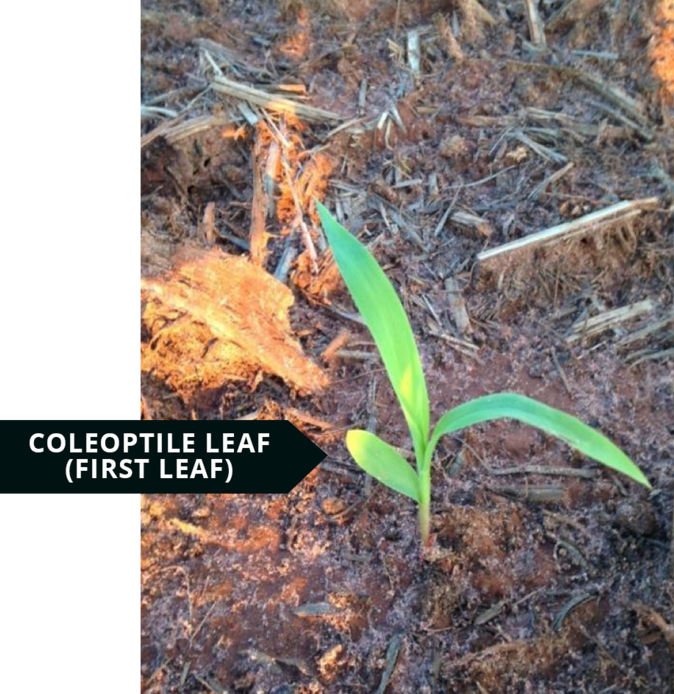

Stage 3. The growing point differentiation (GPD) stage is when the plant changes from vegetative growth to reproductive growth. This stage typically occurs 30 to 40 days after emergence. New leaf development within the whorl ceases; however, the plant continues to grow. Nutrient and water availability and uptake are critical at this stage because of seed head development. Stress during GPD can affect the potential number of seeds per head at flowering. Stage 3 is a key time to apply irrigation, if soil moisture conditions are dry and irrigation is available. Canopy closure helps to reduce the need for weed management. Plants are about 12 to 15 inches in height.
Stage 4. At this stage, the flag leaf, which is shorter than the preceding leaves and the last leaf to emerge prior to head exertion, can be seen in the whorl. The head continues to develop and about 80% of the total leaf area has formed. Nutrient and water uptake requirements continue. Typically, the plant progresses from the flag leaf tip being visible to the boot stage in five to ten days.
Stage 5. Leaves have fully expanded and are maximizing light interception in the boot stage. The head is almost full size and can be found enclosed in the flag leaf sheath. Moisture stress or herbicide injury can cause incomplete head exertion from the sheath. Any part of the head that does not exert from the flag leaf sheath can prevent pollination. With most grain sorghum products, the boot stage occurs approximately 50 to 60 days after emergence. Moisture and heat stress during the boot stage and for the next 14 days can substantially lower yield. The plant progresses from the boot stage to the heading stage in three to five days (Figure 3).
Stage 6. A sorghum plant is in the bloom stage when the rapidly growing peduncle pushes the head through the flag leaf sheath. Blooming is the most critical stage in the life of the sorghum plant. A plant begins flowering from the top of the panicle and progresses downward. A crop is in half bloom when more than half of the plants in the field are in some stage of bloom. It typically takes four to nine days for a single panicle to complete the flowering process. Grain begins to fill, making the crop vulnerable to seed set losses common during hot and dry weather. Products are often rated on their maturity largely based on the length of time the plant takes to reach the half bloom stage (Figure 4).
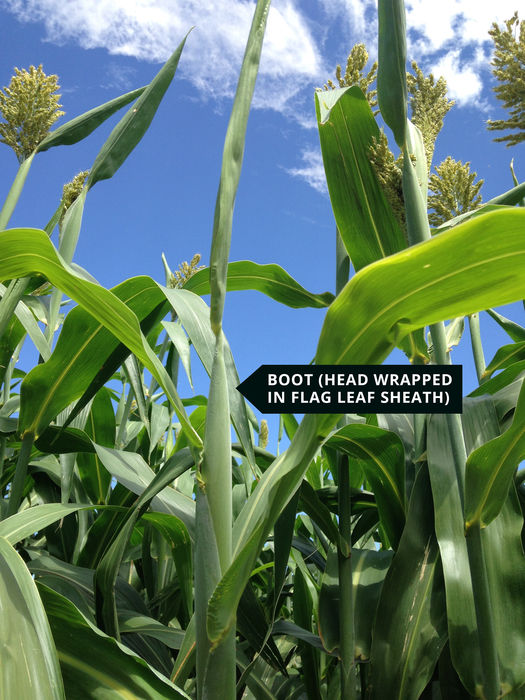

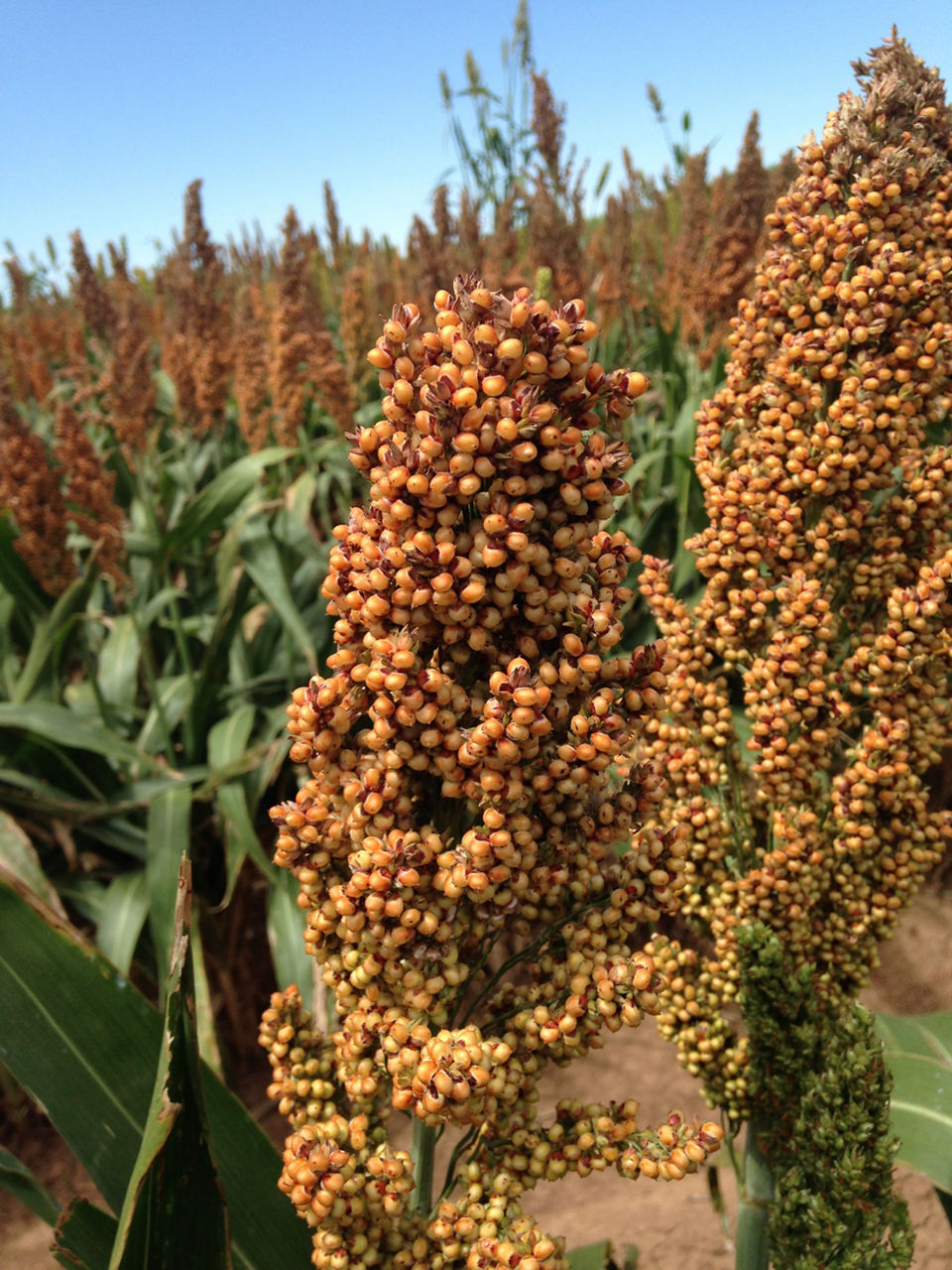
Stage 7. Grain continues to fill during the soft-dough stage. At this stage, starch is rapidly accumulating in the kernel, 50% of the grain's final weight has been achieved, and the whole plant moisture content is approximately 65 to 68%. Older leaves will continue to die, especially under drought stress.
Stage 8. About 75% of the grain final dry weight has been accumulated by the hard dough stage. Nutrient uptake is considered complete. The seed coat is no longer green and has turned its final color, which can be white, cream, bronze or red. Post flowering moisture stress may promote lodging, often associated with charcoal and Fusarium stalk rot, and contribute to light, chaffy grain (Figure 5).2
Stage 9. Sorghum plants have reached physiological maturity when the black layer forms a dark spot visible on the kernel at the base of the seed. Grain moisture content typically varies between 25 to 40% depending on sorghum product selection and growing conditions. Total time from flowering to physiological maturity is approximately 40 to 45 days.1,3
The nutrient requirement of sorghum between growth stages 2 through 6 is critical for crop development. At growth stage 6, sorghum plants have used roughly 60% of the phosphorous, 70% of the nitrogen, and 80% of the potassium required for production, but have only produced 50% of final plant dry weight. As sorghum plants mature, large amounts of nitrogen, phosphorous, and potassium are translocated from the stalk and older leaves to the grain. Limited nutrient availability during grain fill may result in increased leaf loss, which may lead to a reduction in yield potential (Figure 6).1
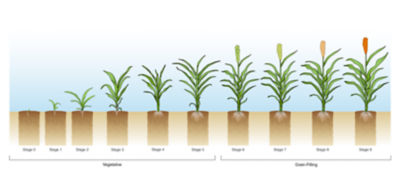
Growing Degree Units (GDUs) to Determine Growth Stage
Estimating the time between different sorghum growth stages and the expected maturity date of a sorghum crop based on days after emergence can be difficult. To more accurately determine crop development, growers can calculate how many GDUs the crop has received.
Calculating Growing Degree Units

The lowest temperature for sorghum development is 50°F, and the highest temperature that may be entered is 100°F. The cumulative GDUs required to reach certain sorghum growth stages differs between short season and full season sorghum products (Table 2).5
Table 2. Cumulative growing degree units (GDU) from planting to successive growth stages for short and full season grain sorghum products.
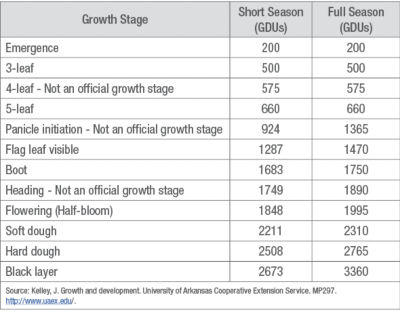
Sources
1 Vanderlip, R.L. 1993. How a sorghum plant develops. Kansas State University. S-3 http://www.bookstore.ksre.ksu.edu
1 Das, I.K., Rajendrakumar, P. 2016. Disease resistance in sorghum. ScienceDirect https://www.sciencedirect.com/topics/agricultural-and-biological-sciences/charcoal-rot#:~:text=Charcoal%20rot%20is%20a%20widespread,inducing%20factors%20for%20the%20disease
3 Gerik, T., Bean, B., and Vanderlip, R. 2003. Sorghum growth and development. Texas Cooperative Extension. B-6137. http://publications.tamu.edu/
4 Growth and development. 2016. United sorghum checkoff program. https://www.sorghumcheckoff.com/for-farmers/grain-production/growth-and-development
5 Kelley, J. 2011. Grain sorghum production handbook: Growth and development. University of Arkansas Cooperative Extension Service. MP 297. https://www.uaex.uada.edu/publications/mp-297.aspx
Web sources verified 05/07/21.
1038_S1